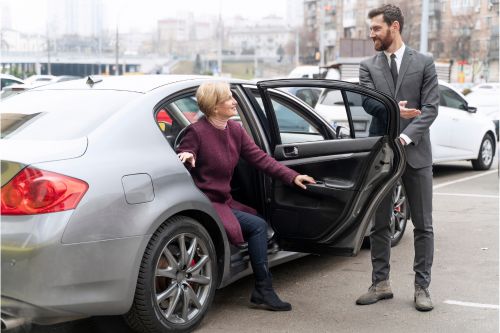Table of Contents
Transportation for students in Australia
Australia, a vast and diverse continent, welcomes students from around the world for education and adventure. As a student, one of the first things you’ll need to familiarize yourself with is the country’s transportation system. Australia offers a well-developed and efficient network of transportation options, making it relatively easy to get around the country. In this blog, we’ll explore the various modes of transportation in Australia to help you navigate this beautiful country.
Public transportation
The most popular and efficient way to get around in Australia’s major cities is public transportation. Here are some key aspects of public transportation in the Australia –
- Trains- Australia boasts an extensive train network, with major cities such as Sydney, Melbourne, Brisbane, Perth, and Adelaide. Its main cities are well-connected by the train routes. Trains are a convenient mode of travel and offer scenic routes for those wanting to explore the countryside.
- Buses- Complementing the train system are buses, providing transportation to areas not covered by trains. You can purchase single tickets or travel cards for bus rides. Bus services are available in cities and regional areas.
- Trams- Melbourne is famous for its tram network, which is the largest in the world. Trams are a convenient way to explore the city and its suburbs. They are easily accessible and cost-effective.
- Ferries- In cities such as Sydney, ferries are integral to the public transportation system. They offer a unique view of the city’s iconic harbors and beaches. Ferry services are also available in other coastal cities of Australia.
- Opal, Myki, and Go Cards- These are the smart cards used for public transportation in Sydney, Melbourne, and Brisbane, respectively. They allow for easy and cost-effective travel across multiple modes of transportation in each city.
Personal vehicles

Owning a personal vehicle can offer convenience and flexibility, especially if you plan to explore more remote areas. Here’s what you need to know about owning and driving a car in Australia-
- Driver’s license- If you’re planning to drive in Australia, you may need to obtain an Australian driver’s license, depending on the state or territory you reside in. International driver’s licenses are generally valid for a limited period.
- Rules for road commutation- Australian road rules may differ from those in your home country. It’s crucial to familiarize yourself with these rules, such as driving on the left side of the road and obeying speed limits.
- Fuel- Readily available in Australia, fuels such as petrol (gasoline), diesel, and LPG (liquefied petroleum gas) are the most common options.
- Road conditions- Australia’s roads are generally well-maintained, but the conditions can greatly vary, especially in rural areas. Keep an eye out for wildlife, as animals often venture onto the roads.
- Parking- In cities, parking can be expensive and limited. It’s recommended to use public transportation for urban travel and use your car for longer trips or exploring the countryside.
Cycling
An eco-friendly and healthy way to get around is cycling. Many cities in Australia are becoming more cycle-friendly. Here’s what you need to know about cycling in the country-
- Bike paths- Major cities have dedicated bike paths, making it safe and convenient to cycle. Melbourne, in particular, has an extensive network of bike paths and lanes.
- Bike-sharing programs- Some cities offer bike-sharing programs, allowing you to rent bicycles for short trips. You can find bike-sharing stations in popular urban areas.
- Helmets- In Australia, wearing a helmet while cycling is mandatory. Be sure to invest in a good-quality helmet for your safety while biking.
Walking
To explore your local surroundings in a new country, walking is the most simple and healthy way. It’s also a great way to soak in Australia’s beautiful landscapes. Consider the following tips for walking in Australia-
- Pedestrian crossings- Always use pedestrian crossings while walking on a busy street, and obey traffic signals.
- Comfortable shoes- Invest in comfortable walking shoes, as you’ll most likely do a fair amount of walking, especially when exploring the cities.
- Safety- While Australia is generally safe for pedestrians, it’s essential to be cautious, especially when crossing streets and walking at night.
Ride-sharing services

Services such as Uber and Lyft offer ride-sharing options that are widely available in major cities across Australia. These services offer a convenient and reliable way to get around urban areas, and you can use the associated mobile apps to request rides.
Domestic travel
Australia’s geographical size makes domestic travel a unique experience. Whether you’re traveling for leisure or returning home, you’ll have various options for getting around the country-
- Domestic flights- Australia’s domestic flight network is extensive, and major airlines such as Qantas, Virgin Australia, and Jetstar provide numerous flight options. This is the quickest way to travel between cities or to remote destinations.
- Long-distance buses- Bus services in Australia connect major cities and regional areas over a long distance. They are a more affordable option than flying and are ideal for travelers on a budget.
- Car rentals- If you prefer flexibility, you can rent a car for domestic travel. Remember that Australia’s vast distances can result in long road trips, so plan your journeys accordingly.
Traveling to remote areas
Australia’s rugged beauty extends far beyond its cities, and exploring remote areas is an adventure in itself. When traveling into the outback or other remote locations, consider the following-
- Safety- Remote areas can present challenges, including extreme weather conditions and limited access to services. Ensure you are well-prepared with the right equipment and knowledge about the areas you are traveling.
- 4WD vehicles- Some remote areas require four-wheel drive (4WD) vehicles for access. Renting a 4WD is an option if you plan to explore such regions.
- Permits- Certain areas, such as national parks, may require permits for access. Check local rules and regulations and obtain the necessary permits in advance.
Key takeaways
- Australia’s major cities offer efficient public transportation options, including trains, buses, trams, and ferries. Invest in smart cards such as Opal, Myki, or Go Cards for seamless travel.
- Owning a car provides flexibility, but be prepared to obtain an Australian driver’s license, follow local road rules (e.g., driving on the left), and be cautious about road conditions and wildlife.
- Many Australian cities have dedicated bike paths, making cycling an eco-friendly and healthy mode of transport. Remember to wear a helmet while cycling, as it is mandatory in the country.
- Walking is a simple and safe way to explore your local surroundings. Use pedestrian crossings and invest in comfortable walking shoes.
If you find this blog informative and have more questions or need further assistance, don’t hesitate to reach out to us. Contact us for additional information, and we’ll be delighted to help you with any queries you may have.
Liked this blog? Read next: Formal letter format | How to make your writing skills perfect?
FAQs
Q1. Can I use my student transportation card on both buses and trains in Australian cities?
Ans- Many student transportation cards are valid for use on multiple modes of public transportation within a city, including buses and trains. However, it’s recommended to check the specific terms and conditions of your card.
Q2. Is it expensive to own and operate a car in Australia as a student?
Ans- Owning and driving a car can be costly in Australia, with expenses including fuel, registration, insurance, and maintenance. It’s important to consider your budget and transportation needs before deciding to own a vehicle.
Q3. What should I do if I lose my public transportation smart card or ticket?
Ans- Contact the local transportation authority to report a lost card or ticket. They can often assist with replacement options and help protect your remaining balance.






